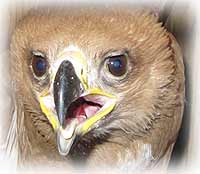![]() Poisons a threat to farmers
Poisons a threat to farmers
[The Namibian
– November 2010]
 An
immature Tawny Eagle, found on a farm southeast of the Etosha National
Park was sent to NARREC (Namibia Animal Rehabilitation research and Education
Centre) for recovery from ingesting a toxic substance. The ongoing call
to Namibian farmers requesting cooperation and advocacy for the safety
of wildlife especially scavenging birds of prey need only fall on one
deaf ear to spoil the attempts of other farmers in the area that are trying
to promote meat production with an environmentally sustainable flavor.
An
immature Tawny Eagle, found on a farm southeast of the Etosha National
Park was sent to NARREC (Namibia Animal Rehabilitation research and Education
Centre) for recovery from ingesting a toxic substance. The ongoing call
to Namibian farmers requesting cooperation and advocacy for the safety
of wildlife especially scavenging birds of prey need only fall on one
deaf ear to spoil the attempts of other farmers in the area that are trying
to promote meat production with an environmentally sustainable flavor.
Worldwide the use of pesticides has come under public and scientific scrutiny as biodiversity and the meaning of sustainable living takes the global stage. Pesticides are hazardous chemical substances for our benefit and they need informed use to not cause personal or environmental harm. The FAO (Food and Agriculture Organization and WHO (World Health Organization) have prepared Africa (and other potential world “food-baskets”) through an enormous input of visual materials, training workshops and regulatory developments on the how, where, when and why of hazardous agricultural chemicals.
For over a decade NARREC, in cooperation with the Ministry’s of Environment and Tourism and Agriculture Water and Forestry, has campaigned for personal and environmental safety from persons using poisonous chemicals in a natural environment. To a large extent the campaign has focused on the issue of secondary and non-target poisonings. In Namibia and elsewhere it is the insectivorous animals and the scavenging birds of prey that become non-target victims of poison use.
Besides information booklets on essential considerations for buyers, sellers, transporters and users of chemical poisons, posters and booklets have given individual persons access to relevant resources on birds of prey, predators on farmlands and the effects of irresponsible poison use. Resources have also been sent to SADC countries in recognition of the movement of birds across political borders.
Namibians are traditionally livestock farmers. Farmers manage large tracts of land and can be seen as land custodians for the nation with all the biodiversity that exists permanently or temporarily on it. The latest resource developed by NARREC provided information to farmers to assist and utilize our magnificent birdlife in an innovative way. “Vulture restaurants” or vulture feeding stations can provide diversification for income generation from tourism on a domestic livestock or game farm. If just one farmer belonging to a conservancy or a farmer association starts such an income-generating project, then any farmer using poison to eliminate predators can damage the initiative.
Many farmers do not need the added bonus of income generation to encourage their support of large birds of prey. These birds provide a number of other benefits to the farm. The question is open as to why farmers, farmer associations and conservancies cannot influence and control one another on the illegal and damaging action of placing poison in the environment.
The Tawny Eagle has amazing adaptations for obtaining food, this allows them to use a variety of habitats throughout sub-Saharan Africa. The Tawny regularly hunts from a perch position, often from the very tops of trees or telephone poles and by so doing they are one of the more commonly seen eagles. Male and female are also often in close proximity. These eagles have a relatively small size foot and a pair will invariably be seen at a vulture-feeding site where they readily scavenge. In Namibia, research in the Khomas region was done on this species two decades ago. The project showed a greater than 50% loss of the adult breeding population of these eagles over a 5 year period. Nearly all accountable deaths were due to deliberate actions and inadvertent, secondary victim poisoning killing by farmers.
For scavenging birds
of prey it only takes a single farmer to ignore or refuse local, national
and global information concerning sustainable living and biodiversity
and a secondary victim, though usually many more than one, is created.
 Liz
Komen
Liz
Komen
NARREC